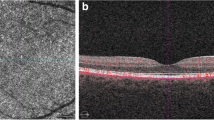Abstract
Purpose
To determine whether significant correlations exist between the foveal microstructures and visual outcomes in eyes with resolved central serous chorioretinopathy (CSC).
Methods
We retrospectively reviewed the medical records of patients who had a complete resolution of the serous retinal detachment (SRD) and had an intact ellipsoid zone in the fovea in the spectral-domain optical coherence tomographic (SD-OCT) images. Twenty-five eyes with CSC (CSC group) and 18 unaffected fellow eyes (control group) of 23 patients were evaluated. The eyes in the CSC group were divided into those with (n = 11) and those without (n = 14) visual disturbances after resolution of the SRD. The thickness of each retinal layer at the fovea was measured in the SD-OCT images.
Results
The photoreceptor outer segment (OS) length in the CSC group was significantly shorter than that in the control group (p = 0.0003). In addition, the photoreceptor OS length in the visual disturbances group was significantly shorter and the duration of SRD was significantly longer than that in the no visual disturbances group (p = 0.0230, p = 0.0021, respectively).
Conclusions
The photoreceptor OS length is a good parameter to indicate the integrity of the foveal photoreceptors in eyes with a resolved CSC.




Similar content being viewed by others
References
Gass JD (1967) Pathogenesis of disciform detachment of the neuroepithelium. Am J Ophthalmol 63:1–139
Spaide RF, Hall L, Haas A, Campeas L, Yannuzzi LA, Fisher YL, Guyer DR, Slakter JS, Sorenson JA, Orlock DA (1996) Indocyanine green videoangiography of older patients with central serous chorioretinopathy. Retina 16:203–213
Klein ML, Van Buskirk EM, Friedman E, Gragoudas E, Chandra S (1974) Experience with nontreatment of central serous choroidopathy. Arch Ophthalmol 91:247–250
Yap EY, Robertson DM (1996) The long-term outcome of central serous chorioretinopathy. Arch Ophthalmol 114:689–692
Iida T, Yannuzzi LA, Spaide RF, Borodoker N, Carvalho CA, Negrao S (2003) Cystoid macular degeneration in chronic central serous chorioretinopathy. Retina 23:1–7
Ficker L, Vafidis G, While A, Leaver P (1988) Long-term follow-up of a prospective trial of argon laser photocoagulation in the treatment of central serous retinopathy. Br J Ophthalmol 72:829–834
Chan WM, Lam DS, Lai TY, Tam BS, Liu DT, Chan CK (2003) Choroidal vascular remodelling in central serous chorioretinopathy after indocyanine green guided photodynamic therapy with verteporfin: a novel treatment at the primary disease level. Br J Ophthalmol 87:1453–1458
Gilbert CM, Owens SL, Smith PD, Fine SL (1984) Long-term follow-up of central serous chorioretinopathy. Br J Ophthalmol 68:815–820
Wang MS, Sander B, Larsen M (2002) Retinal atrophy in idiopathic central serous chorioretinopathy. Am J Ophthalmol 133:787–793
Ojima Y, Hangai M, Sasahara M, Gotoh N, Inoue R, Yasuno Y, Makita S, Yatagai T, Tsujikawa A, Yoshimura N (2007) Three-dimensional imaging of the foveal photoreceptor layer in central serous chorioretinopathy using high-speed optical coherence tomography. Ophthalmology 114:2197–2207
Matsumoto H, Sato T, Kishi S (2009) Outer nuclear layer thickness at the fovea determines visual outcomes in resolved central serous chorioretinopathy. Am J Ophthalmol 148:105–110
Ojima Y, Tsujikawa A, Yamashiro K, Ooto S, Tamura H, Yoshimura N (2010) Restoration of outer segments of foveal photoreceptors after resolution of central serous chorioretinopathy. Jpn J Ophthalmol 54:55–60
Ojima Y, Tsujikawa A, Hangai M, Nakanishi H, Inoue R, Sakamoto A, Yoshimura N (2008) Retinal sensitivity measured with the micro perimeter 1 after resolution of central serous chorioretinopathy. Am J Ophthalmol 146:77–84
Forooghian F, Stetson PF, Meyer SA, Chew EY, Wong WT, Cukras C, Meyerle CB, Ferris FL 3rd (2010) Relationship between photoreceptor outer segment length and visual acuity in diabetic macular edema. Retina 30:63–70
Mohammad S, Gottlob I, Kumar A, Thomas M, Degg C, Sheth V, Proudlock FA (2011) The functional significance of foveal abnormalities in albinism measured using spectral-domain optical tomography. Ophthalmology 118:1645–1652
Chen CJ, Scholl HP, Birch DG, Iwata T, Miller NR, Goldberg MF (2012) Characterizing the phenotype and genotype of a family with occult macular dystrophy. Arch Ophthalmol 130:1554–1559
Shiono A, Kogo J, Klose G, Takeda H, Ueno H, Tokuda N, Inoue J, Matsuzawa A, Kayama N, Ueno S, Takagi H (2013) Photoreceptor outer segment length: a prognostic factor for idiopathic epiretinal membrane surgery. Ophthalmology 120:788–794
Hasegawa T, Ueda T, Okamoto M, Ogata N (2014) Presence of foveal bulge in optical coherence tomographic images in eyes with macular edema associated with branch retinal vein occlusion. Am J Ophthalmol 157:390–396
Piccolino FC, de la Longrais RR, Ravera G, Eandi CM, Ventre L, Abdollahi A, Manea M (2005) The foveal photoreceptor layer and visual acuity loss in central serous chorioretinopathy. Am J Ophthalmol 139:87–99
Eandi CM, Chung JE, Cardillo-Piccolino F, Spaide RF (2005) Optical coherence tomography in unilateral resolved central serous chorioretinopathy. Retina 25:417–421
Fujita K, Shinoda K, Imamura Y, Matsumoto CS, Mizutani Y, Mizota A, Yuzawa M (2012) Correlation of integrity of cone outer segment tips line with retinal sensitivity after half-dose photodynamic therapy for chronic central serous chorioretinopathy. Am J Ophthalmol 154:579–585
Celesia GG, DeMarco PJ Jr (1994) Anatomy and physiology of the visual system. J Clin Neurophysiol 11:482–492
Pu GA, Masland RH (1984) Biochemical interruption of membrane phospholipid renewal in retinal photoreceptor cells. J Neurosci 4:1559–1576
Hata M, Oishi A, Shimozono M, Mandai M, Nishida A, Kurimoto Y (2013) Early changes in foveal thickness in eyes with central serous chorioretinopathy. Retina 33:296–301
Conflicts of interest
The authors have no conflicts of interest.
Author information
Authors and Affiliations
Corresponding author
Rights and permissions
About this article
Cite this article
Hasegawa, T., Okamoto, M., Masuda, N. et al. Relationship between foveal microstructures and visual outcomes in eyes with resolved central serous chorioretinopathy. Graefes Arch Clin Exp Ophthalmol 253, 343–350 (2015). https://doi.org/10.1007/s00417-014-2695-2
Received:
Revised:
Accepted:
Published:
Issue Date:
DOI: https://doi.org/10.1007/s00417-014-2695-2




